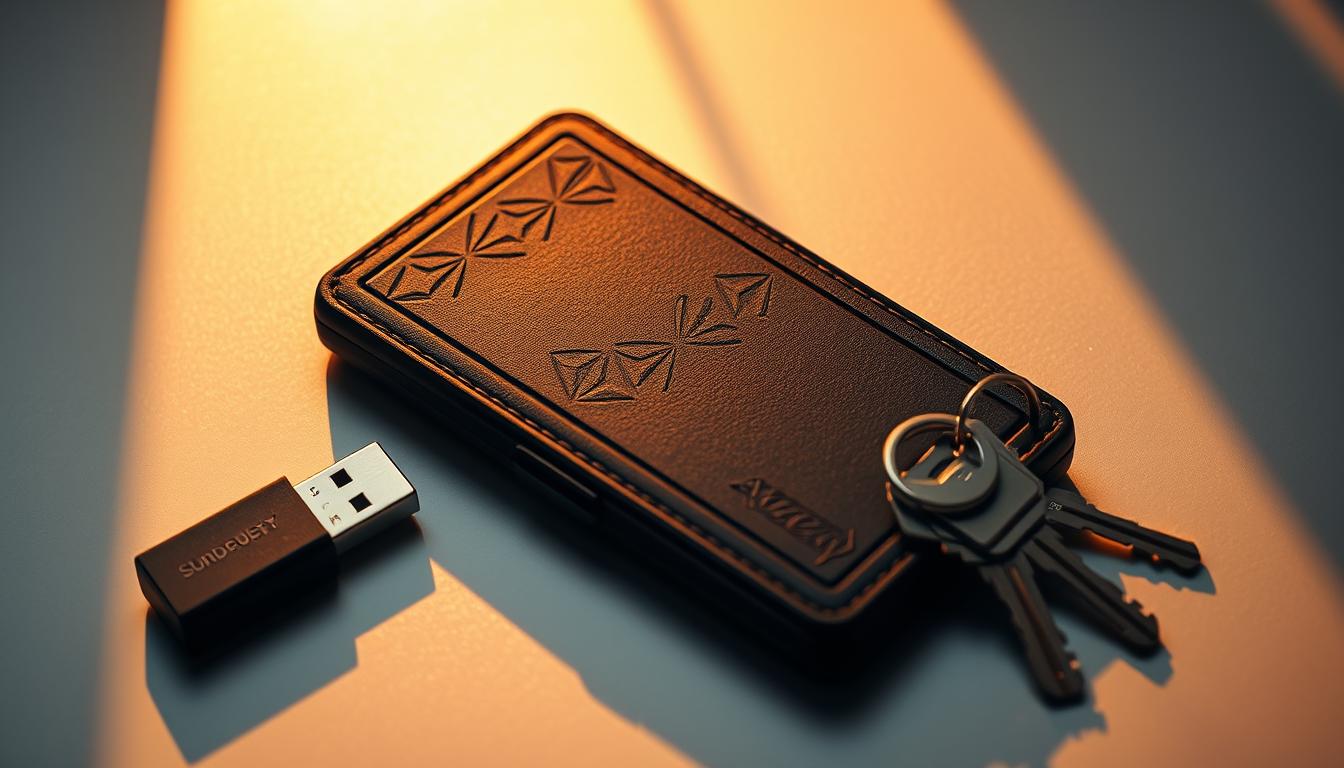Now Reading: Discover Unique NFT Art Collection Digital Gallery Online
- 01
Discover Unique NFT Art Collection Digital Gallery Online
Discover Unique NFT Art Collection Digital Gallery Online
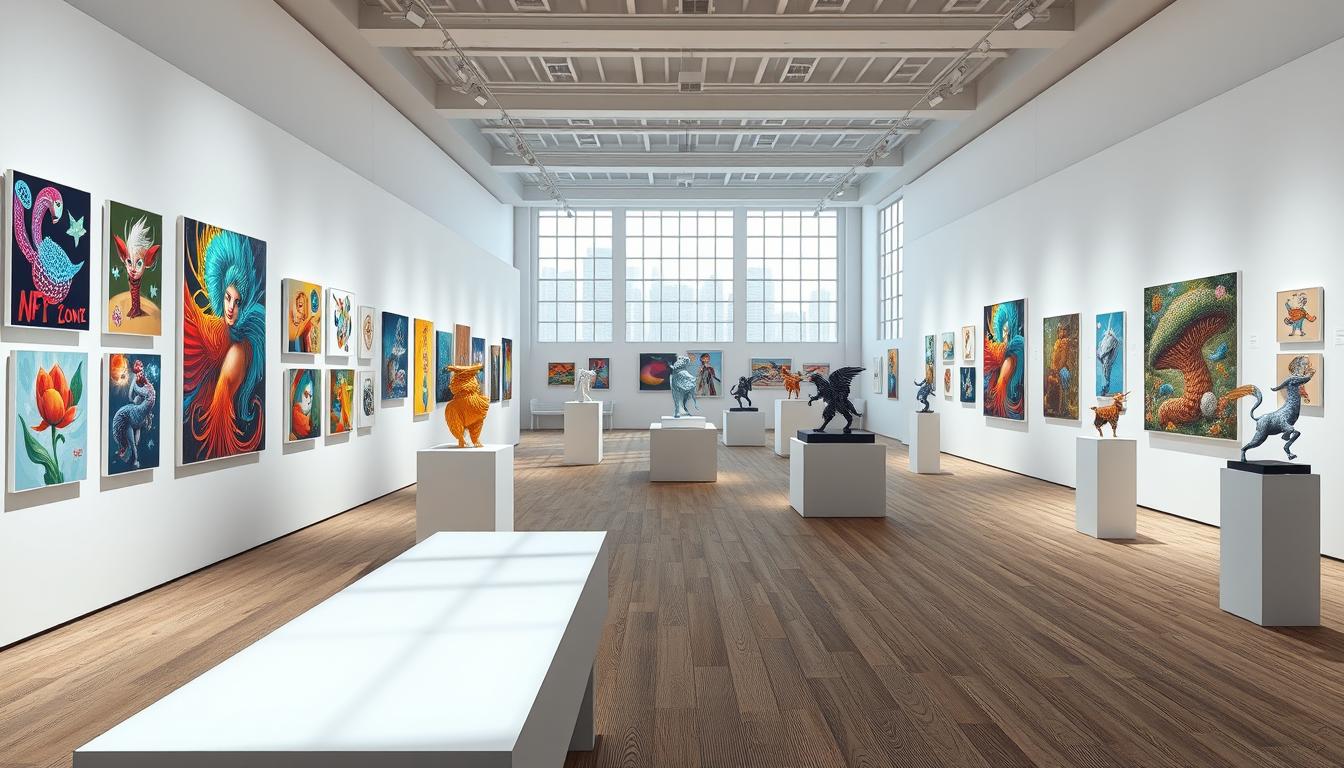
The landscape of creative ownership is undergoing a remarkable transformation. A new type of asset, verified on a blockchain, allows creators to offer truly unique items. These tokens represent proof of authenticity for a specific piece, making each one distinct and irreplaceable.
Unlike traditional cryptocurrencies which are interchangeable, each of these digital certificates has its own value and metadata. This technology underpins a revolutionary way to collect and view contemporary works. Enthusiasts can now explore these pieces in specially curated spaces, similar to traditional exhibitions but with a modern twist.
These virtual spaces, or online showcases, are becoming essential destinations. They offer unprecedented access to top-tier works from artists around the world, all from the comfort of your home. Platforms like Original NFT exemplify this shift, providing a seamless way to discover and acquire verified pieces. This democratises access while ensuring provenance through secure blockchain verification.
Key Takeaways
- Non-fungible tokens are unique digital assets recorded on a blockchain, proving ownership.
- Each token is one-of-a-kind, unlike fungible cryptocurrencies like Bitcoin.
- Specialised online spaces allow you to view and explore these unique items.
- These virtual exhibitions offer global access to contemporary works.
- Blockchain technology guarantees the authenticity and history of each piece.
- This new model provides exciting opportunities for both new and seasoned collectors.
The Evolution of NFT Art and Digital Galleries
The journey of modern artistic expression has taken a decisive turn in recent years. It has moved from the hushed halls of traditional institutions to the dynamic realm of virtual spaces.
This shift represents a fundamental change in how we experience and value creative works.
From Traditional Art Spaces to Virtual Exhibitions
A watershed moment occurred four years ago. Artist Beeple’s record-breaking sale at Christie’s demonstrated that digital creations could rival traditional masterpieces in value and prestige.
Since then, prestigious institutions have embraced this new form. The Louvre, Centre Pompidou, and LACMA now feature these pieces alongside classical works.
LACMA even launched an acquisition fund specifically for digital art by women artists. This institutional acceptance validates the cultural impact of this movement.
The Role of Blockchain in Verifying Digital Art
The backbone of this evolution is blockchain technology. It solves a long-standing problem for digital creations: proving authenticity and ownership.
This system creates an immutable record. It acts as a permanent certificate for each piece, ensuring its scarcity and history are transparent.
This verification is an integral part of the trust required for collectors. For a deeper dive into building a portfolio, see our guide for enthusiasts.
| Aspect | Traditional Physical Art Exhibition | Modern Virtual Exhibition |
|---|---|---|
| Accessibility | Geographically limited | Global access from anywhere |
| Verification | Relies on provenance paperwork | Uses immutable blockchain records |
| Artist Control | Limited after initial sale | Can programme royalties into future sales |
Exploring NFT art collection digital gallery
The boundaries between physical and virtual exhibition spaces are rapidly dissolving. Enthusiasts can now explore creative works in fully immersive metaverse environments and newly established physical locations.
This fusion offers diverse ways to experience contemporary pieces.
Virtual Metaverse Spaces and Physical Gallery Integrations
Platforms like Voxels and Decentraland have become major hubs. They host a variety of unique showcases from established names and emerging creators.
In Voxels, the B.20 space displays famous works by Beeple. The Async Gallery in the Gangnam district is known for its programmable pieces, where layers can change the final image.
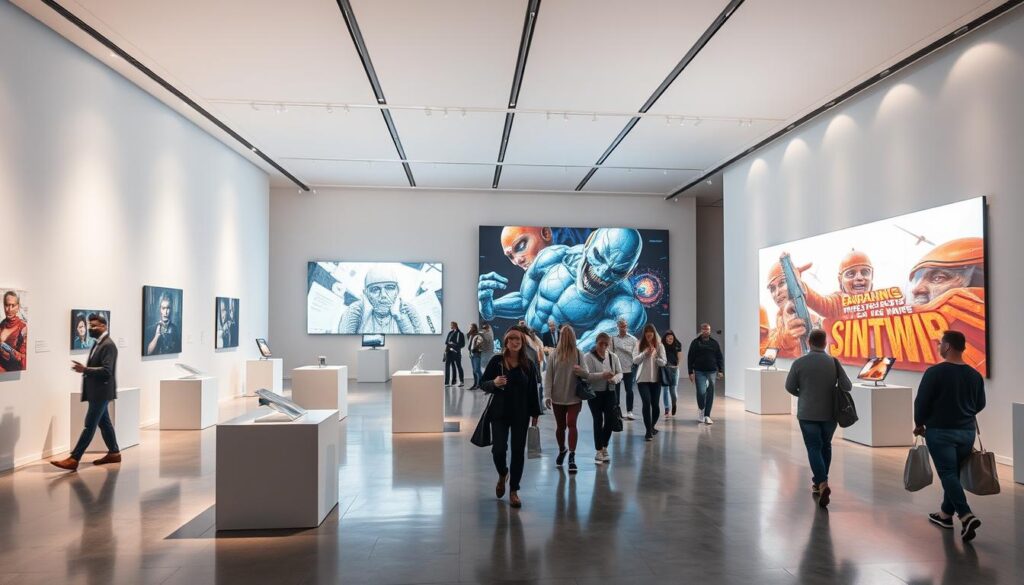
Decentraland boasts impressive venues like the KnownOrigin space with its striking design. The community-focused Narra Gallery empowers creators and collectors to display their projects.
Even prestigious auction houses are involved. Sotheby’s has a meticulous virtual replica of its London gallery in Decentraland.
The experience is also expanding into the real world. New York’s Lower East Side now hosts physical spaces like SuperRare’s “Offline” marketplace and Heft Gallery.
These venues focus on works created with advanced systems, blending Web3 with traditional art scenes.
Innovative Platforms and Tools Fueling Digital Art
The tools available to creators and enthusiasts today are more powerful and accessible than ever. These technologies provide sophisticated yet simple ways to build and experience virtual showcases.
This empowers individuals to curate their own spaces with professional results.
Spatial: Crafting Immersive VR Art Galleries
Spatial stands out as a leading platform for crafting immersive exhibitions. Users download the app, create an account, and can immediately start building.
The technology offers an Auto-Gallery function. This creates a new room in seconds by simply selecting assets.
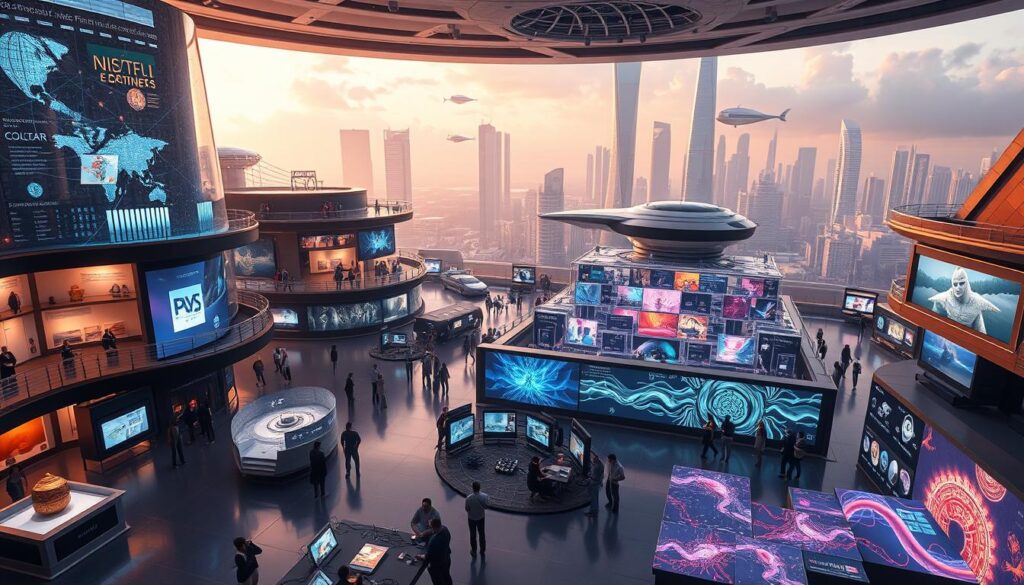
For displaying works, the platform provides dedicated tools. 3D models can be placed on adjustable pedestals. 2D pieces are enhanced with frames and information panels that pull data directly from the blockchain.
Major marketplaces like OpenSea use this technology to host rotating shows. Visitors can view a piece and click through to purchase it.
Seamless Integration of Wallets and NFT Marketplaces
A key strength of these platforms is their seamless integration with digital wallets. By connecting a wallet like MetaMask, users can import their authenticated items directly into a virtual space.
Free platforms like OnCyber and Kunstmatrix offer straightforward ways to get started. For more elaborate projects, users can purchase land in metaverses like Decentraland and collaborate with builders.
| Platform | Best For | Key Feature |
|---|---|---|
| Spatial | Immersive VR Exhibitions | Auto-Gallery & Professional Display Tools |
| OnCyber | Quick & Simple Showcases | Direct Wallet Connection |
| Metaverse Land | Fully Customised Spaces | Collaboration with Builders |
Curating Digital Art: A Comprehensive Buyer’s Guide
For those entering the world of token-based acquisitions, a systematic approach ensures confident decision-making. This guide provides essential steps for building a meaningful portfolio.
Step-by-Step Navigation of NFT Purchases
Begin by setting up a crypto wallet to manage your transactions securely. Many platforms offer straightforward wallet creation processes.
Next, explore both virtual and physical exhibition spaces to view available works. Physical venues often feature large-scale displays with interactive elements.
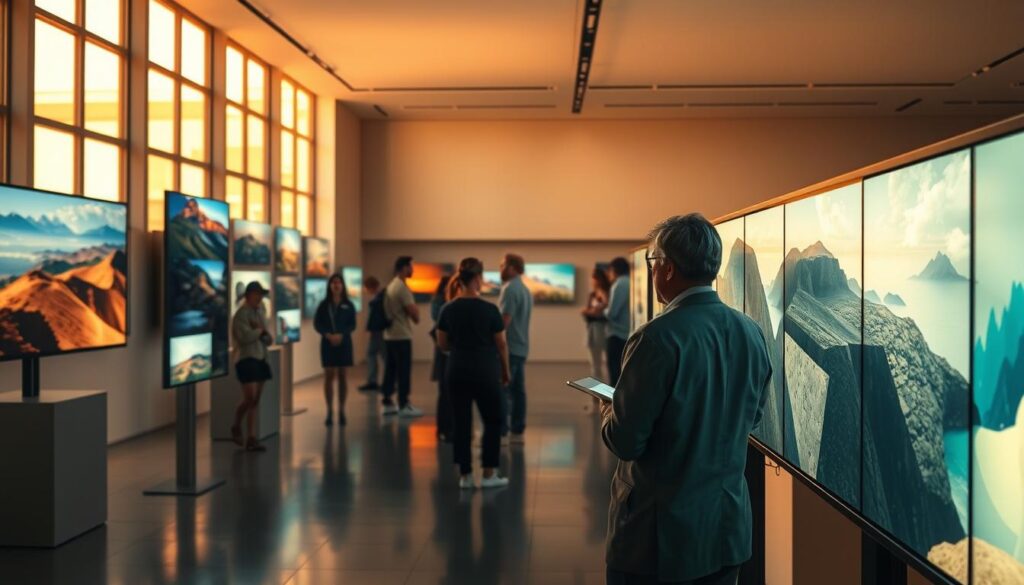
When you find pieces that resonate, verify the token’s authenticity through blockchain records. Galleries like Heft can establish custodial wallets if you prefer not to manage the technical aspects directly.
| Method | Best For | Key Consideration |
|---|---|---|
| Virtual Gallery | Global Access & Exploration | High-resolution digital viewing |
| Physical Exhibition | Immersive Experience | VR/AR installations available |
| Hybrid Approach | Comprehensive Understanding | Combines digital and physical benefits |
Leveraging Technology and Expert Insights on Digital Art
Steven Sacks of Bitforms emphasises understanding the history of new media creations. “If you’re going to collect in this territory, you need to know the history,” he advises.
Gallery programmes bring creators and enthusiasts together, fostering community. Mika Bar-On Nesher notes that every transformative movement faces initial resistance before acceptance.
Today’s market serves diverse collectors, from Web3 natives to traditional buyers expanding their holdings. For deeper guidance on curating and displaying your acquisitions, explore additional resources.
Conclusion
Contemporary art experiences are evolving beyond traditional boundaries into immersive worlds. This transformation creates unprecedented opportunities for global participation in creative communities.
Metaverse platforms and virtual tools democratise access to exhibition spaces. They empower individuals to become curators themselves, breaking down historical barriers.
The upcoming Canyon venue in Manhattan demonstrates continued institutional recognition. This new space for video and digital-based works shows the movement’s growing legitimacy.
Expert perspectives confirm this is not a passing trend. As Mika Bar-On Nesher observes, “We live in a digital world and we can’t escape that.” These creative works represent an integral part of our cultural conversation.
While traditional galleries often underserve this discipline, forward-thinking collectors can play pioneering roles. The community-building aspect of these spaces supports emerging talent while engaging diverse audiences.
Whether collecting individual pieces or creating virtual exhibitions, these platforms offer accessible entry points. They provide meaningful engagement with cutting-edge creative expression in our increasingly connected world.
FAQ
What is a tokenised art gallery?
A tokenised art gallery is a virtual space, often accessible online, where artists can exhibit their works as unique digital tokens on a blockchain. This approach provides a new way for creators to showcase and sell their pieces directly to a global community of collectors, without the limitations of a physical location.
How does blockchain technology benefit artists and collectors?
Blockchain technology offers significant benefits by providing an immutable record of ownership and provenance for each piece. This verification process ensures authenticity, protects the creator’s rights, and gives collectors confidence in the legitimacy of their acquisitions. It creates a transparent and secure environment for all participants.
Can I view these exhibitions without a crypto wallet?
Yes, many platforms allow you to explore the gallery space and view the exhibitions without needing a cryptocurrency wallet. However, to make a purchase or interact fully with the community—such as acquiring a piece—you will typically need to connect a compatible wallet to the platform.
What is the difference between a virtual gallery and a metaverse space?
A virtual gallery is often a dedicated website or application for viewing works. A metaverse space, however, is a more immersive, three-dimensional world where visitors can interact with the environment and other users in real-time, offering a more social and experiential way to engage with the artwork.
Are there opportunities for physical exhibitions of this work?
Absolutely. Many creators and galleries are now integrating physical and digital experiences. This can involve displaying digital pieces on screens in a traditional gallery setting or hosting events where collectors can view their tokenised works in person, blending the best of both worlds.
What tools are essential for starting a collection?
To begin, you will need a digital wallet that supports the relevant blockchain, such as Ethereum. It is also wise to use established marketplaces and platforms that offer robust tools for discovery, verification, and secure transactions. Research and community engagement are key parts of a successful strategy.



